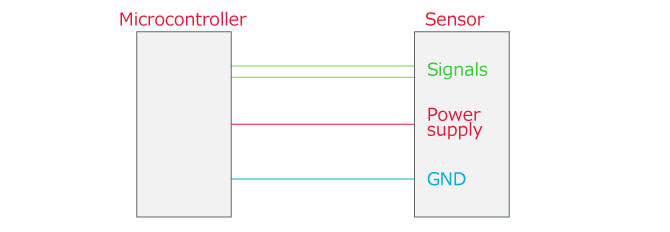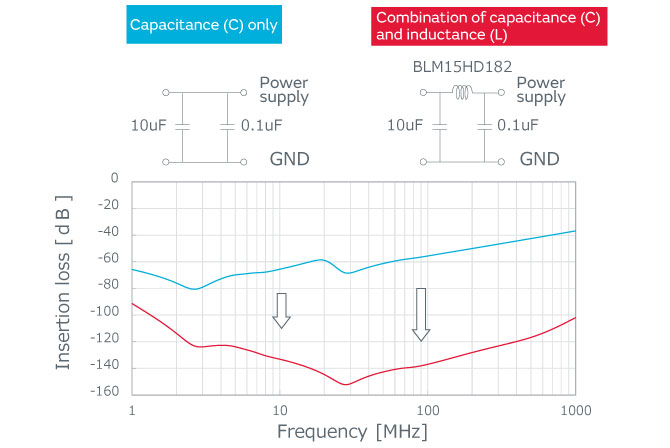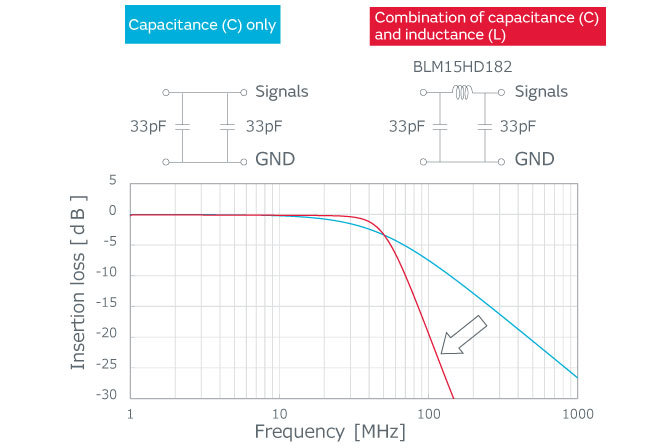Noise suppression technologies/case study introduction (Consumer)
Noise countermeasures for ameliorating sensor malfunction (2)
INDEX
Do you have any problems like these?
We will provide an introduction to the mechanisms of sensor malfunction due to noise.
Mechanisms by which noise causes sensor malfunctions
One-chip sensors mainly consist of three types of lines: signal, power and GND. In addition, communication is performed using multiple signal lines such as Clock and Data. Let’s examine the effects when noise is applied to the various lines.

Application of noise to digital signal lines
When noise is applied to digital signal lines and produces the incorrect judgment that the level has exceeded the High threshold value or fallen below the Low threshold value, this may result in a malfunction where communication cannot be performed correctly.
We actually introduced noise to the digital signal lines of a particular accelerometer for evaluation, and confirmed the malfunction where communication stopped.

Application of noise to power lines
The analog front-end includes amplifier and A/D conversion circuits, and when the power supplies of these circuits fluctuate and the circuits do not operate correctly, a malfunction may occur where abnormal values are output.
We actually introduced noise to the power line of an accelerometer for evaluation, and confirmed the malfunction where the output was disrupted.

As demonstrated above, malfunctions where communication stops or the output values are disrupted occur when noise is applied to the signal or power lines of a one-chip sensor.
Key points of noise countermeasures for sensors
Introduction
The conditions sought in filters used as countermeasures against noise in sensors are described below.
- Pass the power supply and the signals required for operation
- Block the noise that causes malfunctions
Although single-chip type sensors are available in a variety of types and product names, there are no large differences in the filters required as countermeasures for the noise that causes malfunctions.
This is because the two conditions sought in a filter are common to any sensor.
- Pass the power supply and the signals required for operation
→Single-chip type sensors have standardized interfaces (IC pins) - Block the impressed noise that causes malfunctions
→The specifications of the impressed noise are standardized with an immunity test
Mounting position of the filter
The filter needs to be mounted in the vicinity of the sensor to be effective.
Power line noise countermeasures
Filters having a high insertion loss over a wide bandwidth from low frequencies to high frequencies are suitable for use in power line noise countermeasures.
Countermeasures that use only capacitors will require a capacitor with a large capacitance value that covers the low frequency side, and a low ESL capacitor for obtaining a high frequency insertion loss.
Combining capacitors and an inductor provides the advantage of a remarkable increase of the insertion loss. Surpassing the use of an inductor, a more effective filter against noise will be obtained by arranging sufficient capacitance at the sensor side in a multi-level configuration.

Signal line noise countermeasures
Noise countermeasures for (data/clock) signal lines require the design of filters having low insertion loss at the signal frequencies that should be passed.
Countermeasures that only use capacitors are possible when noise levels are small or when the frequencies of the signal and the noise are separated; however, especially when the signal frequency and the noise frequency are close, it becomes necessary to configure filters having sharp insertion loss characteristics by combining inductors and capacitors.

Key points when using inductors
When an inductor is inserted in a specific line only, the line becomes unbalanced and conversion to normal mode (a potential difference) occurs; therefore, there is the likelihood of the malfunctions getting worse. When inserting inductors, it is important that the same part number is used in all of the lines.
*Ferrite beads, an inductor type filter, not only block noise with their high impedance, but also absorb noise energy as a loss by the ferrite, so higher noise countermeasure effectiveness can be expected.
